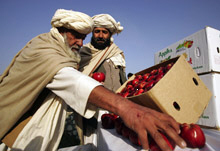
Typical street scene in Santa Ana, El Salvador. (Photo: iStock)
IMF Survey: IMF Announces $1.6 Billion in Debt Relief for Afghanistan
January 26, 2010
- Afghanistan’s external debt to be reduced by about 96 percent
- Government pursues reforms to improve economic security and governance
- Protecting vulnerable groups is a key goal
The IMF Executive Board has endorsed debt relief of about $1.6 billion for the Islamic Republic of Afghanistan, the institution announced on January 26.

Vendors in Kabul: Despite a difficult security situation, Afghanistan’s economic performance has improved noticeably (photo: Newscom)
LOW-INCOME COUNTRIES
The announcement marks the end of a process that included clearance of arrears and debt reductions by Paris Club creditors since 1996 and will be followed by debt relief under the Enhanced Heavily Indebted Poor Countries (HIPC) Initiative, 100 percent debt relief from Paris Club creditors, and debt relief under the Multilateral Debt Relief Initiative.
These actions will lead to a 96 percent reduction of Afghanistan’s external debt, helping Afghanistan to regularize relations with its creditors and request additional support for the war-torn country’s reconstruction and poverty reduction initiatives.
The debt relief was granted in the context of the completion point of the enhanced HIPC initiative, a joint program between the IMF and the World Bank’s International Development Association (IDA).
“Afghanistan’s success in reaching the HIPC completion point is a reflection of its improved economic performance and reforms in the past year, despite a very difficult security and political situation,” said Masood Ahmed, Director of the IMF’s Middle East and Central Asia Department.
Bolstering institutions, governance
To meet the criteria for debt relief, Afghanistan has undertaken reforms to strengthen institutions and improve economic governance, including:
• beginning to implement a poverty reduction strategy and aligning spending priorities with that strategy;
• tracking poverty-related spending;
• publishing data on the quantity and quality of health and education services;
• restructuring key service-delivery ministries;
• producing a medium-term fiscal framework;
• publishing the core budget financial statements;
• designing reforms for the civil service and the military pensions;
• enacting regulations for extraction of minerals and hydrocarbons; and
• establishing an external debt management system.
Afghanistan has recently performed well under a program supported by the Poverty Reduction and Growth Facility (PRGF), the IMF’s lending program for low-income countries (recently renamed the Extended Credit Facility). Under the IMF-supported program, Afghanistan has been implementing measures to increase tax collection and improve governance in tax agencies, keep inflation low, and strengthen the monitoring of public enterprises.
Despite a challenging security situation and political uncertainty in 2009, the country’s economic performance has improved noticeably. Inflation has declined rapidly, the exchange rate has remained stable, and domestic revenues have increased by almost 60 percent. At the same time, economic activity has expanded by about 15 percent, supported by a recovery in agriculture, increased donor inflows, and prudent policies.
An international conference on Afghanistan will take place in London on January 28, with IMF participation. The conference will focus on several areas, including improving security and governance, fostering economic and social development, and building closer regional relationships.
Next steps
Looking ahead—and in addition to the central goal of improving security—Afghanistan faces several challenges, including maintaining macroeconomic stability and promoting sustained growth by investing in infrastructure, providing a better environment for private sector activities, and fighting corruption.
“IMF involvement with Afghanistan has been sustained and intensive, and will continue to be so after this milestone,” said Enrique Gelbard, the IMF’s mission chief for Afghanistan. “The government has expressed interest in a new three-year economic program that can be supported by the Fund, and we will be discussing such a program in coming weeks.”
Afghanistan’s debt relief comes two weeks after the IMF Executive Board completed the sixth review of the country’s program, which triggered a disbursement of $8.9 million. This latest payment brings the total of IMF financial assistance since 2006 to $118.5 million. The Board also approved an extension of the program to June 2010 to allow more time for implementation of pending reforms on customs administration and the monitoring of public enterprises.







